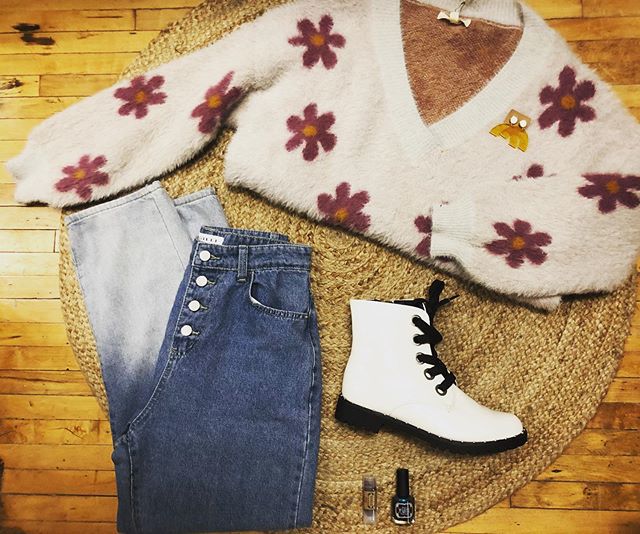Women small business-owners curate a shopping experience in the internet age
November 12, 2019
Boutiques play an integral role in the fashion industry by contributing to the fashion culture in small towns as well as bigger cities.
We the Dreamerz, a boutique in Ames, and others like it strive for their unique style, atmosphere and experience to compete with larger retailers. However, the question remains if these small businesses will survive the onslaught of the internet and online shopping.
Oftentimes a boutique’s style reflects the owner’s personality and their many changing moods. Owner of We the Dreamerz, Jade Dirks, shows dedication to local artists by filling the store with one of a kind items from a wide variety of people. No cut of pants, shirts or dresses is too represented, no style of clothing is too prominent on the racks. Dirks’ store is a reflection of her personality and its many seasons.
After a chance meeting with Dirks at JOANN Fabric & Craft, Rachel Gai, senior in marketing, began selling her clothes at We the Dreamerz. Gai started making her clothes as a way to express herself without having to go shopping. After a brief break at the start of her college career, she came back stronger than ever to build her brand. Rachel Reloaded recently celebrated two years at We the Dreamerz. Gai’s marketing major is now a safety net for the emerging artist.
“I think that the need for individuality and custom apparel and being able to find things that work with you and are made for you is very important now,” Gai said. “I think that people are looking to stray away from fast fashion brands that are constantly throwing out clothes.”
According to EcoWatch, the fashion industry is the second highest contributor to pollution. It takes up to 5,000 gallons of water to produce one t-shirt and a pair of jeans. Cotton alone takes up 10 percent of the world’s chemicals, but it only covers 2.4 percent of cropland.
According to Linda Niehm, a professor and the program director in the apparel, merchandising and design department at Iowa State, 75 million Americans in the millennial generation are responsible for the current prevalence of boutiques. The generation holds authenticity and sustainability to a higher value than those before it.
“Consumers – they want an experience,” Niehm said. “They don’t want just a product. You know if you can make my life better if you can make me feel like I am escaping from the monotony and the stress of my daily life if you can preselect things for me […] it is looking at lifestyle, convenience and enjoyment factors of your customers not just about a product.”
With the internet, boutiques need to focus on moving the experience online. Small businesses lack the manpower, capital and sometimes the knowledge to produce a website and successful social media presence. Dirks said she designed her website alone, and she is actively working on learning more about websites.
According to Jessica Hurst, an associate professor in apparel, merchandising and design, boutiques need to focus on highlighting their unique retail strengths online.
“For example, if customer service and their product knowledge is a strength of theirs, they need to also translate that to their online presence,” Hurst said. “I think these specialty retailers that offer this customized and special service to their customers need to also translate that to their website if they want to sell online as well.”
Hurst made a point to acknowledge the older generation of shop owners may feel uncomfortable with the internet, recalling her time at her internship. The shoe store owner kept all her records by the book and would walk up to the storeroom above the shop and count her sales every night, tallying them up by hand. The thought of doing this online seemed nearly impossible.
“I wanted to take all of her inventory and put it into a Microsoft Excel spreadsheet for her,” Hurst said. “She did it all by hand. All by book. She did not trust the computer. The computer would crash. […] It was this daunting process of doing it all by hand when I would have just loved to put it in a spreadsheet for her that can just calculate.”
She made the spreadsheet much to the disappointment of her employer. To this day, when she goes back to the store to check in on her former boss, Hurst said she knows the little old woman selling shoes still walks up the stairs, searches through her storeroom and jots each pair of shoes down in her trusty book. Hurst doubts she ever touched the spreadsheet in the first place.
According to Dirks, only 15 to 20 percent of her profits come from her website. Most of her money comes from the two physical locations in Carroll, Iowa and Ames, Iowa. She is even looking into a mobile boutique sometime in the future.
The same goes for The Diva Inside boutiques. Owner Jodi Hamilton even sees a difference between locations with her store in Boone, Iowa, a town of around 13,000 people, taking in more money than her Ames location, a town of around 67,000 people. The Diva Inside also pulls in money from local events.
Along with adapting the experience to the online world, boutiques have to worry about setting prices that won’t scare people away. Clothing retailers may charge fees when smaller boutiques can’t reach production minimums. Boutiques are put in an awkward position: buy too many or pay the price. The common stereotype is small boutiques charge more, but customers who want authenticity and individuality do not mind the higher price point.
“The first thing I think it is better quality,” said Emma VanRyswyk, junior in apparel, merchandising and design, and frequent boutique shopper. “Like going into a small boutique that one person owns and buys for takes a lot of pride in the stuff that they sell. […] I also feel that if I buy a sweater from a boutique and I wear it for my AMD classes, 10 other people are not going to have the exact same thing like if it is from Target. It is more individual to me.”
According to Niehm, boutiques should stay away from what she calls “the price game.” Boutiques get caught up in the corporate competition between the small businesses and the clothing giants. Successful boutiques need to pay attention to the needs of the customer and what they are willing to spend. Otherwise, Niehm warns, you risk devaluing your products.
“You are never going to be able to go head to head with major retailers, bigger retailers because they are always going to volume buying power,” Niehm said. “Price is not something you should be competing on. You should be competing more on those relational aspects, those experiential aspects those other added things that are meaningful to your customer.”
It was a purse at the Iowa State Fair that turned Jodi Hamilton, owner of The Diva Inside boutiques, to turn to the world of fashion. After convincing her husband, she opened one room of her house as a test run. The original version of The Diva Inside was little more than a jewelry store, with a few shelves and a chandelier. It had a door separate from the rest of the house, but there was a limit to how many times people could ask to use the bathroom. After about a year of successful business, the Hamiltons bought the first mobile boutique in Iowa.
The duo traveled to community events and girls’ nights to serve their little community in Boone. When it wasn’t on the road, the mobile shop sat in their driveway. Finally, they decided to open their first permanent location in Boone, Iowa. The Diva Inside had finally graduated from an idea to a full-blown store.
Hamilton and her family have dealt with major challenges with their business, but nothing compares to the internet. The more prevalent the internet became, the more dedicated she had to become to her website and Facebook. She would prefer to spend her time interacting with those that show up in person. Outfits and photos need to be flashy to draw in her audience online. Hamilton worries how long businesses like hers will survive.
“The ones that know how to market to people and do really good with their websites, yes,” Hamilton said. “Those of them like me — that I really like to cater to — the people that come in and shop, I don’t know.”







